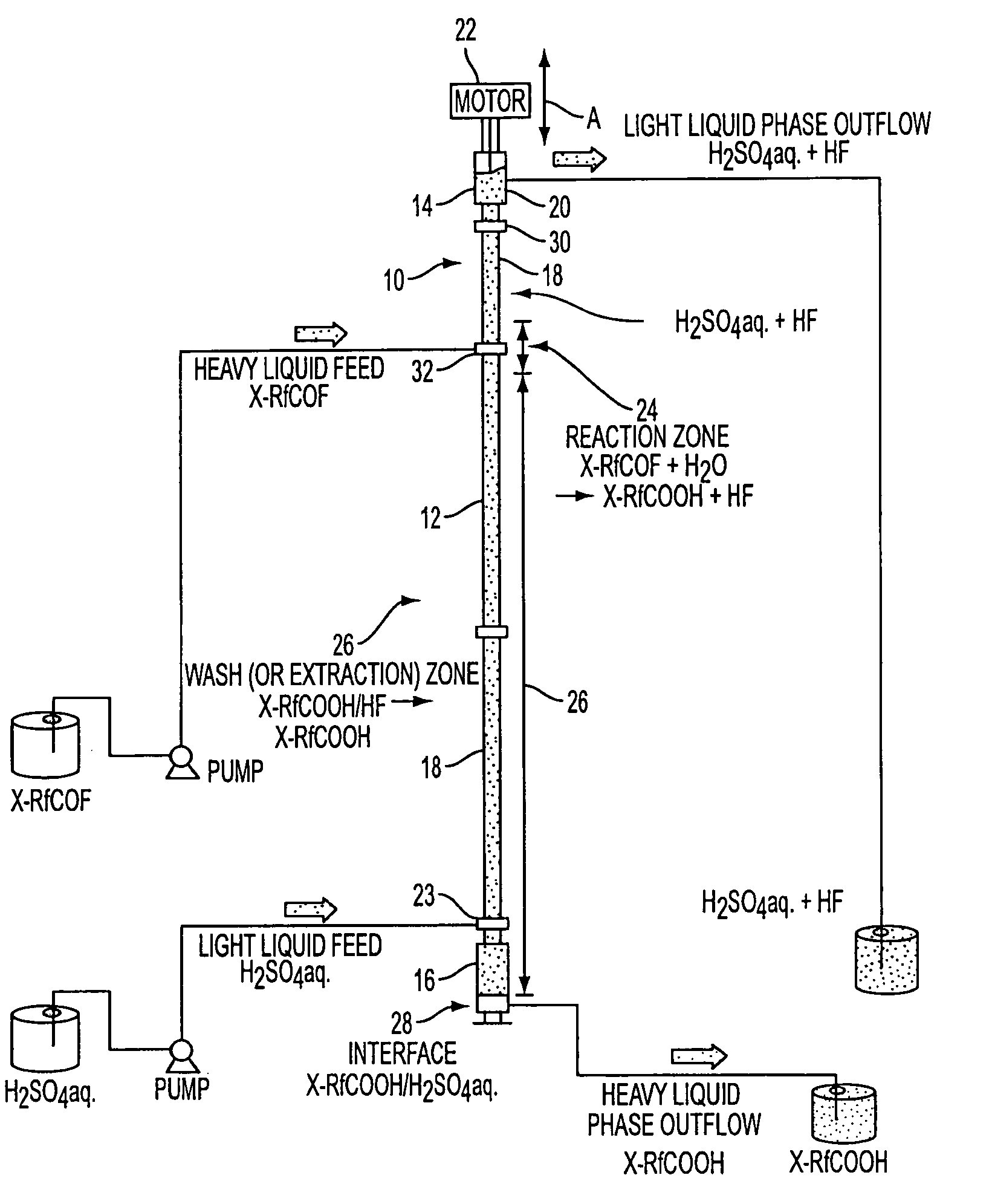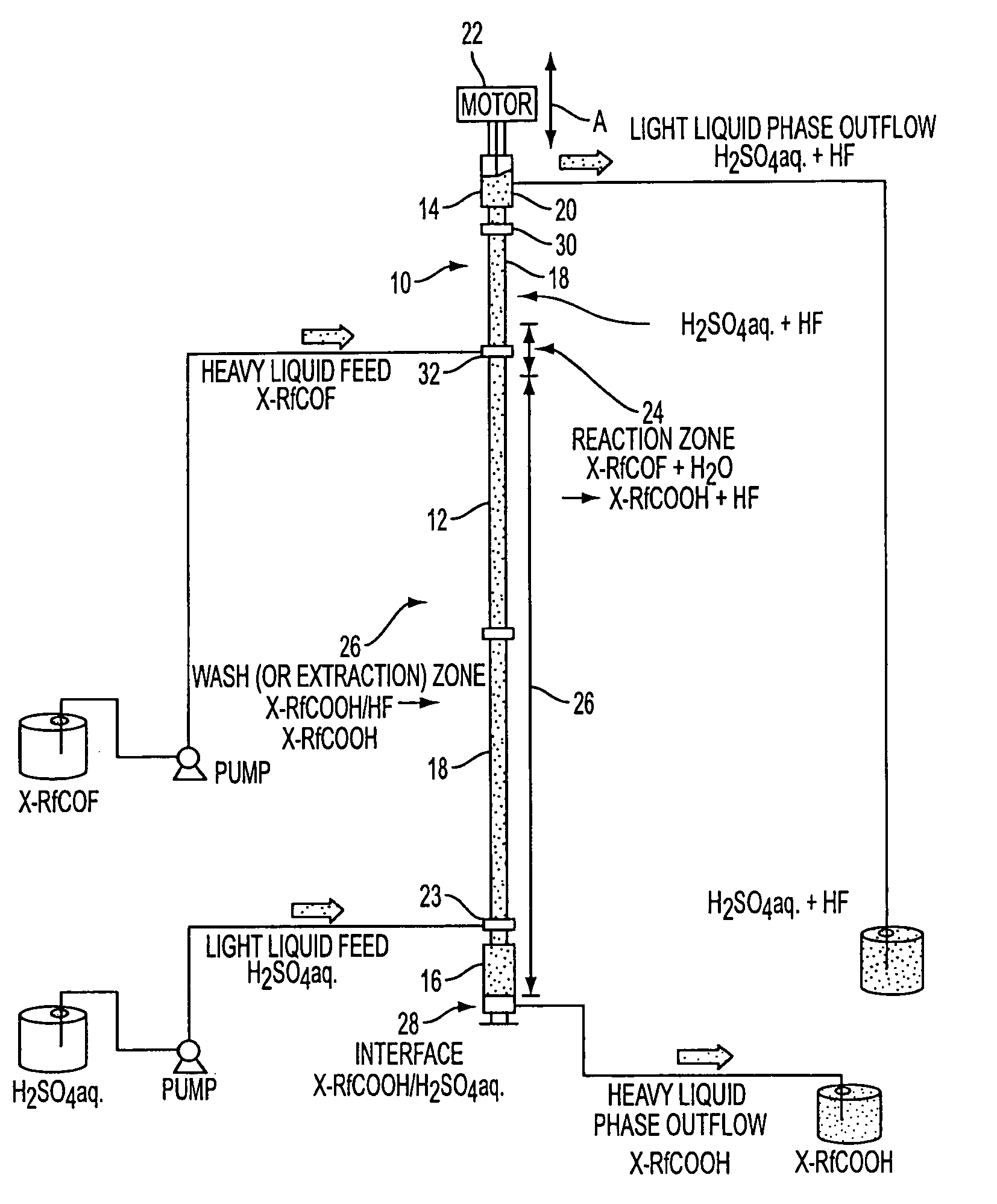Process for preparing fluorocarboxylic acids
a technology of fluorocarboxylic acid and process, applied in the preparation of carboxylic acid halides, organic chemistry, separation/purification of carboxylic compounds, etc., can solve the problems of increasing the complexity of perfluorocarboxylic acid purification, process equipment, and inability to lend itself readily to industrial applications, etc., to reduce the loss from the production system and minimize the release
- Summary
- Abstract
- Description
- Claims
- Application Information
AI Technical Summary
Benefits of technology
Problems solved by technology
Method used
Image
Examples
example 1
Batchwise Reaction / Washing
[0080]A 250 ml perfluoroalkoxy resin (PFA) vessel equipped with a stirrer was used. A 15 wt % aqueous sulfuric acid solution (100 g) was temperature conditioned to 60° C. within the vessel, following which C7F15COF (50 g, 0.120 mol; prepared by the method described in JP-A 8-231462) having a purity of 99.9 wt % was added dropwise over a period of two minutes to the aqueous sulfuric acid solution under stirring. Stirring was carried out thereafter for 15 minutes, after which the mixture is allowed to stand for 15 minutes, resulting in liquid separation into a top phase and a bottom phase. The bottom phase was an organic phase containing C7F15COOH, and the top phase was an aqueous phase containing water and sulfuric acid. This mixture exhibited good liquid-liquid separation.
[0081]The bottom phase was separated off and recovered, following which its composition was determined. The following results were obtained.
[0082]
C7F15COOH93wt %H2O6.5wt %H2SO43,290ppm by ...
examples 2 to 5
[0088]Aside from varying the sulfuric acid concentration of the aqueous sulfuric acid solution used in hydrolysis and washing, the procedure followed in each of these examples was the same as that in Example 1. The top and bottom phases obtained after hydrolysis and after the two washes were analyzed. The results are given in Table 1 below.
example 6
[0089]Aside from changing the temperature of the aqueous sulfuric acid solution used in hydrolysis and washing to 80° C., the same procedure was followed as in Example 1. The top and bottom phases obtained after hydrolysis and after the two washes were analyzed. The results are given in Table 1 below.
[0090]
TABLE 1Measured compositions of top and bottom phasesafter hydrolysis and after washing.Top phase(H2SO4 aq. phase)Bottom phase (C7F15COOH phase)C7F15COOHC7F15COOHHFH2SO4Examplesconcentrationconcentrationconcentrationconcentration(H2SO4(ppm by weight)(wt %)(ppm by weight)(ppm by weight)concentration,afterafterafterafterafterafterafterafterwt %)hydrolysiswashinghydrolysiswashinghydrolysiswashinghydrolysiswashing2 (5)2,3603,22058387,63048642,50044,0003 (10)102689802,6007113,00013,5004 (20)132693951,25093,5003,6005 (30)18349493951,280174,1904,2706 (15)212589881,690242,4702,950
PUM
| Property | Measurement | Unit |
|---|---|---|
| melting point | aaaaa | aaaaa |
| temperature | aaaaa | aaaaa |
| temperature | aaaaa | aaaaa |
Abstract
Description
Claims
Application Information
 Login to View More
Login to View More - R&D
- Intellectual Property
- Life Sciences
- Materials
- Tech Scout
- Unparalleled Data Quality
- Higher Quality Content
- 60% Fewer Hallucinations
Browse by: Latest US Patents, China's latest patents, Technical Efficacy Thesaurus, Application Domain, Technology Topic, Popular Technical Reports.
© 2025 PatSnap. All rights reserved.Legal|Privacy policy|Modern Slavery Act Transparency Statement|Sitemap|About US| Contact US: help@patsnap.com


